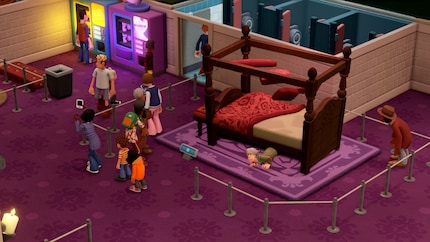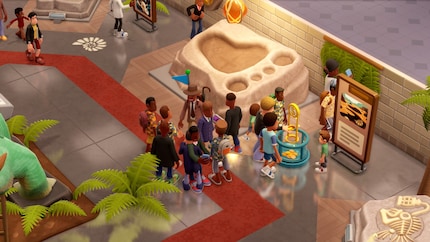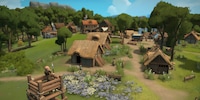
Review
Foundation is a brilliantly chaotic and creative building game
by Debora Pape

My museum has specially designed spaces for dinosaur fossils, warm-water fish and ghosts. The economic simulation Two Point Museum’s very refined, but it fails to motivate me in the long term.
It’s the latest spin-off from the Two Point game series, which so far consists of Two Point Hospital and Two Point Campus. The games are similar in style and share a quirky sense of humour. In Two Point Museum – you guessed it – you build your own museum. As museum director, your job is to create exciting exhibits from different subject areas to impress crowds of visitors.
In the campaign, I take over a large, empty building I’m supposed to transform into a major attraction. I’ve already been provided with a box containing a large exhibit from the field of prehistory: a fossilised dinosaur footprint. I place this interesting item in the middle of the room with a few decorative objects around it. Attractive presentation increases visitors’ «enthusiasm» in the object.
An information board’s also a must, because visitors want to learn something too. So, the boards are part of my repertoire for inspiring the masses.
After setting up a till, it’s almost time to get started. I hire an expert in prehistory to dust off the exhibit from time to time. Assistants man the till, caretakers ensure the museum’s clean, and security guards collect money from donation boxes, among other things.
At the start, you can only select a few destinations on the map. Other locations have to be unlocked through the research team’s particular attributes, special equipment or a certain progress in the museum. Little by little, I plunder my way through the region and grab all the exhibits I can.
Sometimes the expeditions are dangerous. But you can rule out a lot of risks by having a first aid kit or certain characteristics in your crew. Nevertheless, injuries such as facial fractures do happen. In the worst-case scenario, team members can even get lost.
One thing’s certain: every standard expedition brings back a new exhibit. The trips only last a few minutes, and I quickly collected a basic set of items, such as fossilised floppy disks, a prehistoric man encased in amber, and dinosaur skeletons. Skeletons are made up of several finds put together over the course of multiple trips. Only when a skeleton is complete does it reveal its full potential to draw in crowds.
After a few hours of playtime, the quests get on my nerves. But I need them to expand my collection. Since it takes time to carefully prepare for an exhibition, I rush to complete them. Choose a target on the map, bring in the right specialists, add some equipment and off you go.
This doesn’t make sense, because you should cover certain areas to optimise your exhibits. But I don’t want to think about what I need from where and what travel equipment would be best every single minute. Completing expeditions quickly becomes a tedious assembly line job for me.
I’d prefer longer expeditions with more rewards. My team automatically asks me to make the odd decision while they’re on the move. But it’s a basic feature and offers neither excitement nor interesting content.
After a while, I have some items in duplicate or triplicate. They differ in quality: an «epic» fossil’s more exciting than the same fossil of «average» quality. I get my experts to analyse the less valuable ones in a lab.
This destroys them, but increases knowledge of the type of object. This means you can give the public more information about newly found exhibits. More «enlightenment» also unlocks new decorative items.
It’s a strange system. Why can you only get prehistoric-style rubbish bins or decorative wall torches by using knowledge points? Why doesn’t newly acquired knowledge also count for existing exhibits?
After all, it’s more fun to unlock new objects than to sell off pieces you’ve found multiple times for a few dollars.
Speaking of motivation, employees gain experience through their work, enabling them to complete further training if you create a suitable learning space. This gives them useful new skills – but also makes them demand higher pay.
In the workshop, technically gifted employees build new objects, such as interactive stations for children and visitors who don’t want to concentrate on information boards. I also get equipment for expeditions manufactured here. For some construction projects, my expedition teams have to bring the necessary materials with them.
At the beginning – at least in the campaign – the focus is on prehistory. This includes frozen exhibits, such as a fridge in a block of ice. I have to use air conditioning units to make sure things stay in deep freeze.
I quickly learn there are more subject areas. I’m moved to a new map and given the task of building a museum for underwater worlds – aquariums are in demand. We’re talking about room-sized aquatic worlds here, not small glass cases. In my aquariums, I keep aquatic animals from warm, temperate and cold climate zones, so I have to make sure the temperature settings are right.
You need underwater experts for the expeditions to acquire new exhibits. Otherwise, the principle is the same as in the prehistoric department: collect exhibits, display and decorate them under the right conditions, make the information accessible and – of course – collect the money.
It’s similar for botany, desert, space and ghosts. Yes, your museum can house futuristic artefacts from outer space and the spirit world.
I find the ghost exhibition particularly interesting. In addition to haunted clocks and spooky dolls, I also have ghosts. They need to be kept in specially designed rooms in accordance with their species, similar to fish. Ghosts expect their rooms to be decorated and furnished to suit their status; otherwise they become unhappy and disappear. Psychological therapy from my ghost experts is also part of caring for (undead) exhibits.
The mouse controls work really well. In games where almost everything revolves around building and furnishing, it’s important that the process isn’t frustrating or fiddly, and the developers at Two Point Studios have just mastered this. Holding down the mouse enables me to pick up furnishings to rotate and move them. Doors and windows can be easily inserted into walls. You can even pick up and move entire rooms or save them as a template to use later.
The big plus of Two Point Museum is the creative building. You have almost complete freedom when it comes to building walls and defining walkways. This allows you to build your very own museum labyrinth.
The campaign works as a tutorial. It provides a good introduction to the concept of the game. After a few hours, though, I want to keep going at my own pace and start a sandbox save game so I no longer have to meet any goals to access all the themed areas. I just choose one of the initial regions that roughly correspond to the available themed worlds and start from the beginning.
You can adjust the difficulty level in sandbox mode and decide for yourself whether and which themed departments to open. All expedition regions are also available right from the start. However, you still have to unlock the individual goals as usual.
In sandbox mode, you also have the option of offering tours of your museum and advertising it through a marketing office. Tours bring in more money – if they’re done well. To do this, you set a route through the museum that’s neither too long nor too short and covers as many «exciting» objects as possible. An expert then leads visitors through the hallowed halls.
You can open new museum buildings by buying neighbouring properties. This allows you to easily divide your museum into different themed areas. But it’s also easy to accommodate different departments in the same building. It also makes sense to build additional helipads so several expeditions can be carried out at the same time.
My museum’s getting bigger and bigger, and I have to deal with criminals who want to steal my valuable exhibits. There are training courses for this too.
Two Point Museum will be available from 4 March 2025 for PS5, Xbox, PC, Linux and macOS. The PC version was provided to me by Sega for testing purposes.
Two Point Museum is beautifully made. It’s a joy to see crowds of people moving through the rooms and marvelling at my exhibits. I have a lot of fun with it for a few hours. But then the gameplay’s effectiveness wears off, despite the well-meaning entertainment and decoration options.
Everything boils down to the expeditions: without them, there are no new exhibits, no lighting and no new decorations. There aren’t many other challenges. No bottlenecks to overcome, no transport routes to optimise, and no coveted goals that I want to work towards.
I felt the same about Two Point Hospital. In comparison, though, I like Two Point Museum much more. The different themed areas provide variety in the design, instead of copying and pasting the same rooms over and over again.
Apart from the lack of medium-term motivation, there’s not much to complain about. Two Point Museum runs flawlessly, is easy to use and has a sense of humour that many other economic simulations lack.
Pro
Contra
Feels just as comfortable in front of a gaming PC as she does in a hammock in the garden. Likes the Roman Empire, container ships and science fiction books. Focuses mostly on unearthing news stories about IT and smart products.
Which films, shows, books, games or board games are genuinely great? Recommendations from our personal experience.
Show all«Handed in to the lost property office: children’s shoes, badly torn» – the friendly loudspeaker announcement that echoes through my exhibition rooms in Two Point Museum sounds dramatic. The voice doesn’t give a reason for the damage, but I have a suspicion: there are large carnivorous plants in my botany department and visitors don’t seem to be worried about touching the exhibits. But the serious-sounding introduction is misleading: Two Point Museum is a non-violent building game.
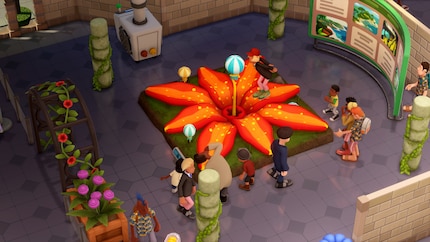
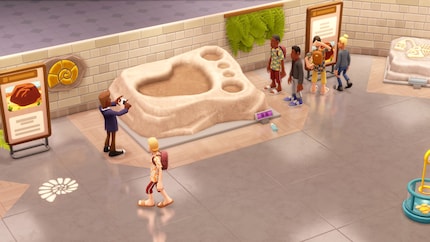
Now queues are forming at my till and visitors are jostling to see my first exhibit. They’re taking photos and marvelling – and I think I saw someone who wanted to know more and licked the stone. The public’s very willing to donate, and I happily pocket the money.
I use the money to finance expeditions to the «Bone Belt», an area of the map where my team finds new prehistoric exhibits. It reminds me of economic simulator Jurassic World Evolution 2. To start an expedition, select a destination on the map and send employees to the museum’s helipad. You need a suitable team for each destination. And it’s not just prehistoric experts who are in demand; other professional groups are sought-after too.
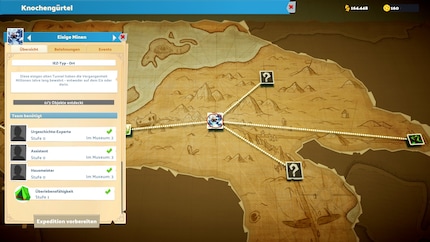
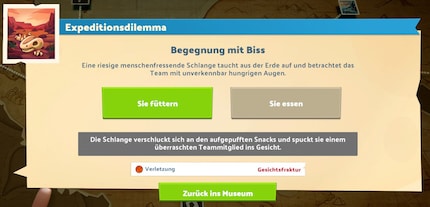
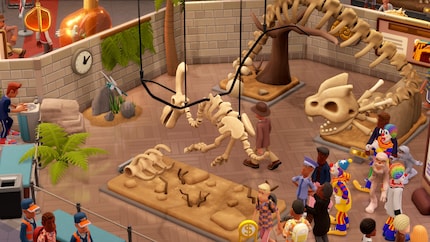
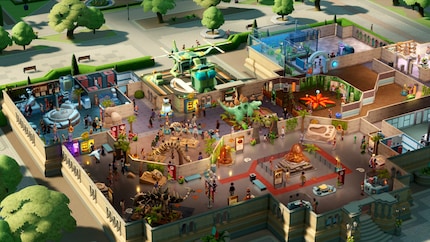
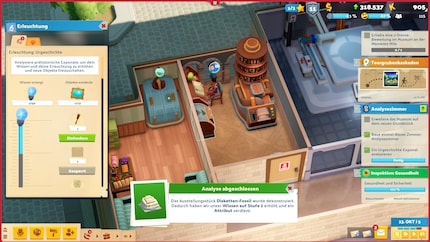
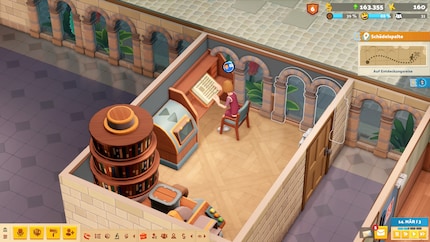
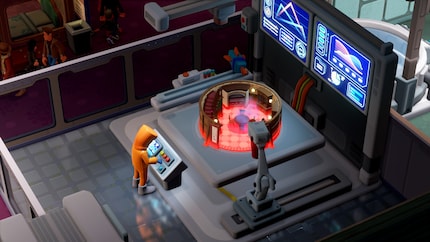
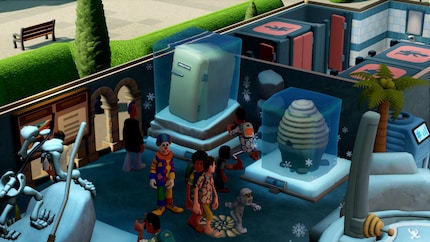
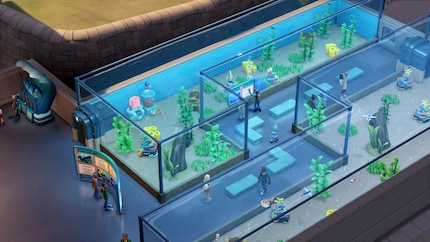
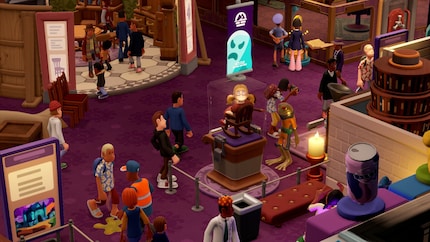
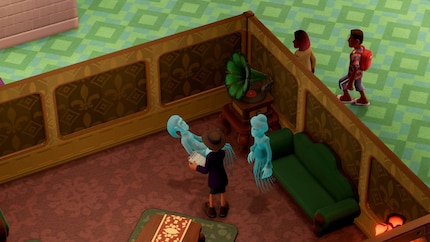
When decorating for ghosts, I also have to consider their taste. There are ghosts from different eras, and Victorian ghosts want different interiors to natural spirits or medieval ghosts.
Like other games in the series, Two Point Museum looks super cute. The graphics are comic-like and it’s worth taking a closer look at the game. Visitors are swallowed by plants and turned into clowns or dragged under a bed on display by a ghost.
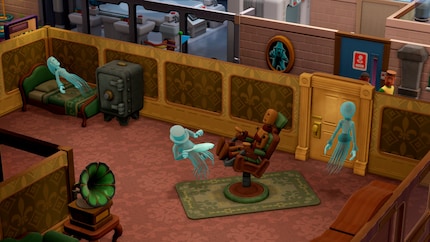
As in Two Point Hospital, highlights are the loudspeaker announcements and the radio programme running in the background. The friendly voice makes random, mostly extremely pointless announcements – «Unfortunately, no parking spaces can be made available for spaceships at the moment» – and gives information about events, such as the expedition team leaving and returning. The radio features funny live reports and adverts. For example, I find out that a new film about incontinent aliens is playing in the cinema.
